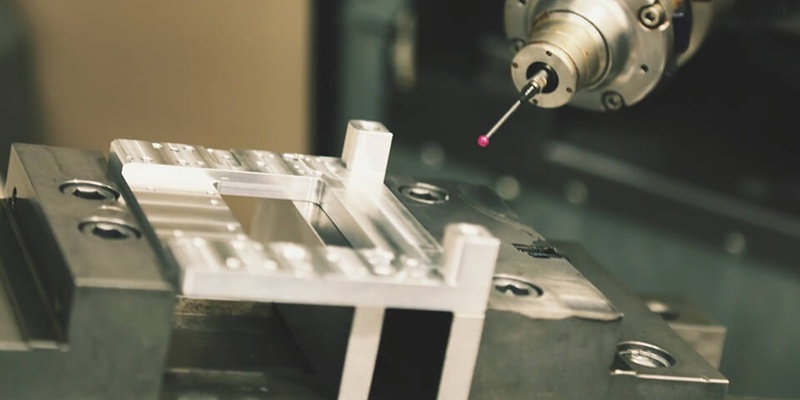- June 16, 2023
Workholding fixtures are an inseparable part of a CNC machine shop. As CNC machining has evolved over the years and parts are getting more and more complex, a lot of research has also been conducted on CNC fixture design. Yet they are not as widely discussed as other developments, though their role in precise part positioning and machining accuracy is undeniable.
In this article, we will dissect the topic of CNC fixtures and discuss several innovative types of CNC fixtures.
Types of CNC Fixtures
Let us dive straight into the topic. A machining fixture can be of many types, depending on the part, machine, and machinist. The following sections on types of CNC fixtures will aim to cover the main types found in a machinist’s workholding toolbox.
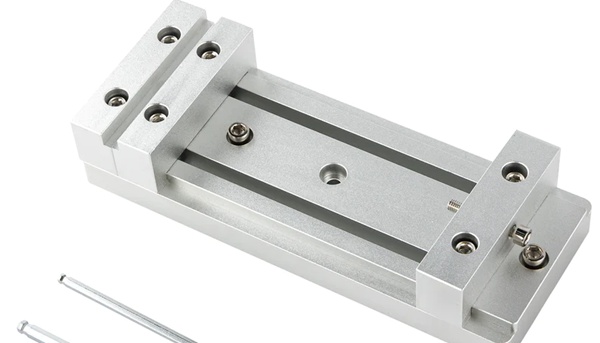
CNC Vise Fixture
CNC vises are the go-to machining fixture for most machining setups because of their versatility and ease of use. Deriving from the traditional mechanical vise popular in woodworking and manual fabrication, they are the more precise version of it.
CNC vises offer incredible clamping power through a hydraulic/pneumatic screw mechanism. Their internal mechanism features two inclined surfaces (like a wedge) pushed against each other to increase rigidity and tackle jaw lift.
Furthermore, they also have flat, precision ground edges on their outer periphery. These faces are perpendicular to each other, allowing accurate positioning of the vise on the worktable or custom fixtures.
Another feature is their jaw design. Although seemingly flat, their surface texture and clamping power create high clamping pressures that tightly grip the part during machining.
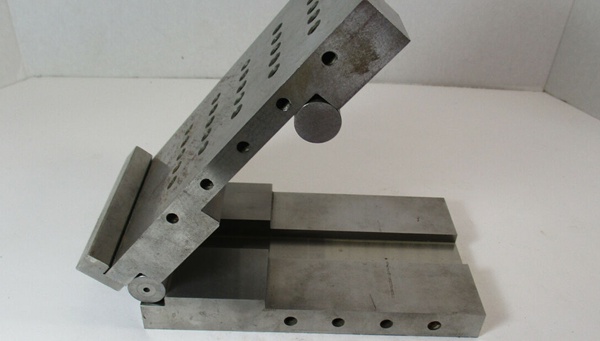
Angle Fixture
Angle fixtures are another common tool among CNC workholding fixtures. Their primary purpose is to hold the workpiece firmly at specific angles. Its common applications include chamfering, beveling, and drilling at angles.
Like the CNC vise, angle fixtures are reliable and rigid. The angle plate often comes with a hole grid for convenient part placement and mounting. Moreover, many products also feature an adjustable angle with a locking mechanism, allowing machinists to customize it according to their needs.
Angle fixtures offer great utility to machinists working with parts beyond their machine’s capability. For example, a prismatic part with a couple of angled surfaces can be easily machined on a 3-axis machine with an angled fixture. At the same time, it can also be machined on a 4-axis machine, but with additional cost.
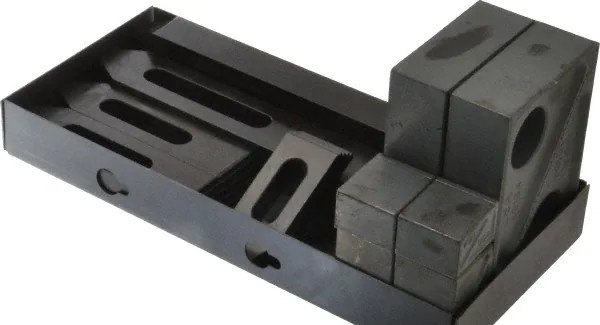
Clamp Fixture
Clamps come in a variety of types and shapes, but the basic purpose remains the same. They hold the workpiece firmly through the application of mechanical force. This force often comes from screws or springs. Some popular clamp types are step clamps, edge clamps, hold-down clamps, and toe clamps.
Although clamps are not necessarily a CNC fixture, per se, they certainly fall within the broad category. Thus, they are worth a mention here.
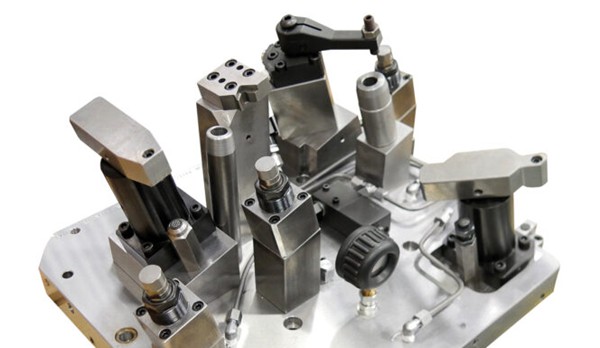
Jig Fixture
Jigs are important machining fixtures that are used to guide the motion of the cutting tool and locate them precisely over the workpiece. A common application of jigs is drilling. If a part has multiple holes at different locations, using a jib with pre-drilled holes (like a stencil) is very time-efficient.
There are several types of jigs:
- Plate jig
- Template jig
- Angle jig
- Leaf jig
- Diameter jig
It is important to mention that many engineers make a distinction between jigs and fixtures owing to the special function of jigs, which guide the tool’s motion. Fixtures, on the other hand, are strictly defined as devices that hold and locate the workpiece. Regardless of this distinction, jigs, and fixtures, both fall under the broad category of work holding and often work side by side.
Indexing Fixture
Indexing fixtures are highly useful in manufacturing parts with evenly-spaced geometric patterns. For example, a circular part with a hole every 30 degrees. Some of its common applications include cutting slots, gear teeth, and cutter flutes, all of which are evenly-spaced geometric features.
CNC indexing fixtures are robust and can be conveniently attached to the worktable. Moreover, modern CNC indexing heads can be automated with servo-control and actuated directly from the machine’s controller or a standalone control unit.
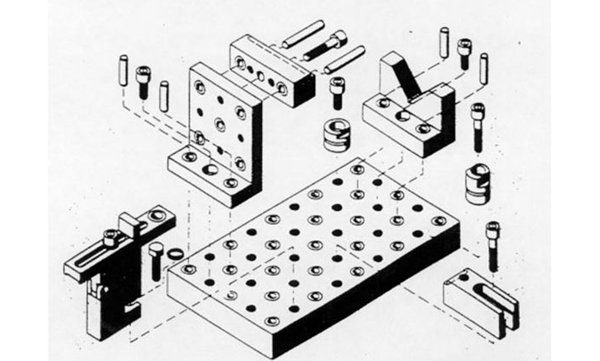
Modular Fixture
Modular fixtures are among the most innovative types of CNC fixtures in this list. They are not part of any standard fixture system and geometry, like vises and clamps. Instead, they consist of a wide range of interchangeable components that can be assembled to form a customized fixture setup unique to the specific job at hand.
These reconfigurable components include plates, clamps, supports, and locators of various sizes. Furthermore, assembling them is quick and easy, and is done with locators or fasteners.
Modular fixtures offer numerous advantages. Since they are adaptable to different applications, they save costs by reducing investments in specialized fixtures. Moreover, they are accurate locators and expandable to larger setups.
Considerations for CNC Fixture Design
CNC fixture design can be quite a complex process. Depending upon the part design and machine capabilities, the process difficulty can vary. We will share some expert tips to make the process of designing CNC workholding fixtures more manageable and systematic.
1. Clearly Define the Design Requirements of Your CNC Fixture
As with any engineering project, CNC fixture design starts with defining the problem. In this context, the designers should clarify their goals regarding production accuracy, cost, timing, etc. to get a clear picture of what they are aiming for.
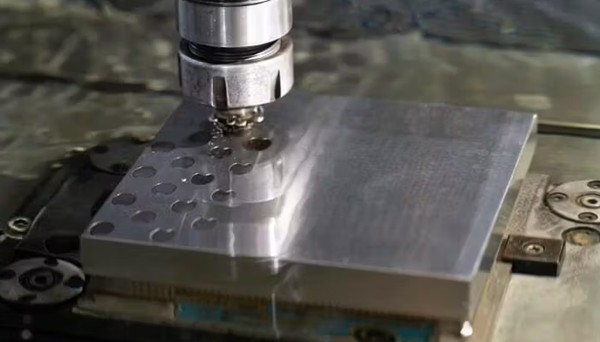
2. Collect Relevant Information From the Shop
The next step is to gather information about your resources. This includes the types of CNC machines you have, the materials your fixture will work with, the number of machining operations and their sequence, and, of course, the workpiece specifications.
3. Develop More Than One Draft for CNC Fixture Design
The good thing about CNC workholding fixtures is that there is never only one solution. You can be creative with fixture design and come up with multiple workholding solutions. As a designer, it is best practice to collect all ideas and prepare a basic draft design for each for comparison.
4. Pick the Best CNC Fixture Idea
Once you have multiple ideas on the table, the next step is to weigh their pros and cons in light of your project’s specific requirements. Finally, after some deliberation, you will settle on the best option for your application. Make sure to consider everything including manufacturing costs, tooling costs, maintenance, and product life.
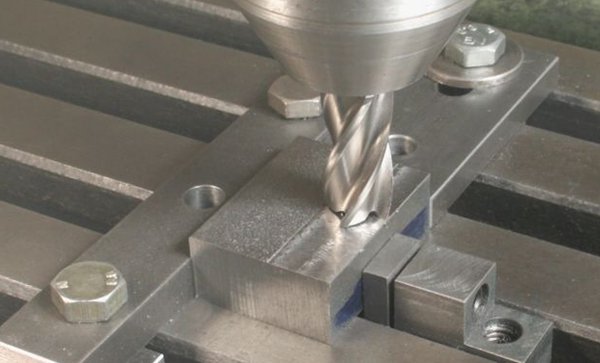
5. Optimize and Implement the Chosen CNC Fixture
In the last step, fine-tune the design you choose and finalize its production plans. The goal is to maximize fixture accuracy and cost-effectiveness. Expert advice is to try your best to stick to standard components like clamps, studs, plates, etc. to benefit from their quality and low cost.
Moreover, another recommendation is to not focus too much on the finishing as it is just a fixture. Only apply expensive surface finish methods where necessary.
Furthermore, the final tip is a bit counterintuitive but useful. Extra-tight part tolerances should also be avoided. They do not necessarily improve positioning accuracy but add cost. Usually, machinists can easily eliminate small fixture inaccuracies during setup and part positioning.
Advanced CNC Fixture Techniques for Machined Parts
The field of CNC fixture design is developing as fast as machining technology itself. The advent of Industry 4.0 has allowed CNC workholding fixtures to evolve into intelligent devices. In the following sections, we will discuss some of these developments.
1. Robotic Fixture Loading
Machining fixture loading/unloading has always been time-consuming. Modern machine shops are now saving a lot of time with robotic fixture loading and unloading. Not only is it quick but also much more accurate than manual loading.
Additionally, robotic arms can store hundreds of routines, allowing manufacturing engineers to automate loading/unloading for their entire product fleet with just one robot.
2. CNC Fixture Monitoring
Monitoring the process and setup through the CNC fixture is also an exciting application of modern technologies in this field. Some fixture designers employ sensor measurements at different locations on the fixture to monitor things like clamping force, part validation, and confirmation of fixture location.
3. Fixture Damping
Damping is an important factor for suppressing machining vibrations, which can be catastrophic for the part in cases like chatter. Certain types of CNC fixtures employ special damping materials that can absorb machining forces while keeping the part stable and well-located. This is a great solution for avoiding problems like chatter.
Do I Need a Custom CNC Fixture?
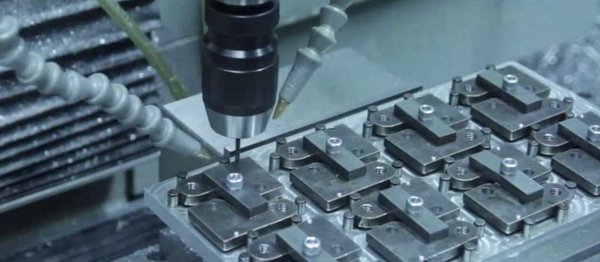
In previous sections, we talked about numerous types of CNC fixtures. However, even with so many machining fixtures in the market, it is not always possible to hold and locate certain parts using standard fixture solutions.
In this case, you may think about a custom CNC fixture. As the name suggests, it is a tailor-made fixture for a specific application.
Technically speaking, it is easy to decide whether you need a customer fixture or not. If standard solutions do not cut it, you need them. However, you should also consider factors like the cost of designing and manufacturing custom CNC workholding fixtures and the return on investment. It is more of a business decision than an engineering decision.
Another aspect to consider is the availability of engineering resources to develop a custom CNC fixture. It is a highly technical task and requires attention to detail by the designers. WayKen provides high-quality production services including custom fixture design and manufacturing.
Conclusion
CNC workholding fixtures are undoubtedly a crucial element of the machining industry, playing a critical role in upholding its quality standards. With numerous types of CNC fixtures, it is also a versatile field in engineering design.
WayKen is a professional rapid manufacturing company. Our talented team and dedicated manufacturing tools make us well-equipped to handle your custom machined parts and CNC fixture needs. Contact us to discuss your projects and get a quote.
FAQs
What type of workpieces can CNC fixtures hold?
CNC fixtures are flexible devices that can hold round, prismatic, plates, cylindrical, and irregularly shaped parts.
Are CNC fixtures interchangeable between different CNC machines?
Most CNC fixtures are interchangeable due to their standard geometric features. In rare cases, however, this may not be possible if the machine specifications differ significantly or the fixture is custom-made.
How to choose the right CNC fixture for my application?
There are several factors to consider such as workpiece dimensions, shape, material, machining operations, sequence of these operations, and the CNC machine’s capabilities.

